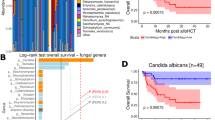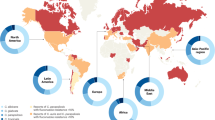Abstract
Most hematogenous candidiasis originates from endogenous host flora. The impact of clinically prominent Candida colonization on short-term mortality (⩽14 weeks) was prospectively studied in 193 hospitalized patients from 1998 to 1999. Clinically prominent colonization included yeasts isolated from all sterile body sites and >50 colonies of Candida from non-sterile sites. Fourteen (7.1%) patients were granulocytopenic (ANC ⩽100/μl). Nineteen (9.8%) had undergone marrow transplantation, 26 (13.5%) had a hematologic malignancy and 129 (66.5) had non-hematologic cancer. Candida isolates (216) were collected form 210 specimens. Fifty-three (27.5%) patients died; 25 (19.4%) with solid tumors, compared to 16 (61.5%) with hematological malignancy, and 11 (57.9%) BMT recipients (P < 0.001). No deaths were seen in patients with AIDS, and one (7.7%) in a patient with a benign condition (P < 0.001). Twenty-six (29.2%) patients with respiratory tract, 13 (23.2%) with gastrointestinal tract, and three (14.3%) with genitourinary tract colonization died. In patients with multiple-site colonization, mortality was significantly higher (45.5%) (P < 0.05). Mortality was higher in patients with C. glabrata (52.9%) and C. krusei (75%) colonization than with C. albicans (24.1%) (P < 0.025). This study shows that patients with hematologic cancer and recipients of marrow transplant with Candida colonization of multiple body sites, and colonization with C. glabata or C. krusei have poor survival.
This is a preview of subscription content, access via your institution
Access options
Subscribe to this journal
Receive 12 print issues and online access
$259.00 per year
only $21.58 per issue
Buy this article
- Purchase on Springer Link
- Instant access to full article PDF
Prices may be subject to local taxes which are calculated during checkout
Similar content being viewed by others
References
Safdar A, Armstrong D . Infectious morbidity in critically ill patients with cancer Crit Care Clin 2001 17: 531 570
Uzun O, Ascioglu S, Anaissie EJ, Rex JH . Risk factors and predictors of outcome in patients with cancer and breakthrough candidemia Clin Infect Dis 2001 32: 1713 1717
Wey SB, Mori M, Pfaller MA et al. Hospital-acquired candidemia: the attributable mortality and excess length of stay Arch Intern Med 1998 148: 2642 2645
Pfaller MA . Nosocomial candidiasis: emerging species, reservoirs, and modes of transmission Clin Infect Dis 1996 22: (Suppl. 2) 89 94
Rex JH . Catheters and candidemia Clin Infect Dis 1996 22: 467 470
Safdar A, Chaturvedi V, Cross EW et al. Prospective study of Candida species in patients at a comprehensive cancer center Antimicrob Agents Chemother 2001 45: 2129 2133
Iwen PC, Kelly DM, Reed EC, Hinrichs SH . Invasive infection due to Candida krusei in immunocompromised patients not treated with fluconazole Clin Infect Dis 1995 20: 342 347
Nguyen MH, Peacock JE, Morris AJ et al. The changing face of candidemia: emergence of non-Candida albicans species and antifungal resistance Am J Med 1996 100: 617 623
Safdar A, van Rhee F, Henslee-Downey JP et al. Candida glabrata and Candida krusei fungemia after high-risk allogeneic marrow transplantation: no adverse effect of low-dose fluconazole prophylaxis on incidence and outcome Bone Marrow Transplant 2001 28: 873 878
Wingard JR . Importance of Candida species other than C. albicans as pathogens in oncology patients Clin Infect Dis 1995 20: 115 125
Meunier-Carpentier F, Kiehn TE, Armstrong D . Fungemia in the immunocompromised host. Changing patterns, antigenemia, high mortality Am J Med 1981 71: 363 370
Abbas J, Bodey GP, Hanna HA et al. Candida krusei fungemia: an escalating serious infection in immunocompromised patients Arch Intern Med 2000 160: 2659 2664
Hovi L, Saarinen-Pihkala UM, Vettenranta K, Saxen H . Invasive fungal infections in pediatric bone marrow transplant recipients: single center experience of 10 years Bone Marrow Transplant 2000 26: 999 1004
Alangaden G, Chandrasekar PH, Bailey E, Khaliq Y . Antifungal prophylaxis with low-dose fluconazole during bone marrow transplantation. The Bone Marrow Transplantation Team Bone Marrow Transplant 1994 14: 919 924
Toor AA, van Burik JA, Weisdorf DJ . Infections during mobilizing chemotherapy and following autologous stem cell transplantation Bone Marrow Transplant 2001 28: 1129 1134
Laverdiere M, Rotstein C, Bow EJ et al. Impact of fluconazole prophylaxis on fungal colonization and infection rates in neutropenic patients. The Canadian Fluconazole Study J Antimicrob Chemother 2000 46: 1001 1008
Paterson PJ, McWhinney PH, Potter M et al. The combination of oral amphotericin B with azoles prevents the emergence of resistant Candida species in neutropenic patients Br J Haematol 2001 112: 175 180
Chandrasekar PH, Gatny CM . The effect of fluconazole prophylaxis on fungal colonization in neutropenic cancer patients. Bone Marrow Transplantation Team J Antimicrob Chemother 1994 33: 309 318
Wingard JR, Merz WG, Rinaldi MG et al. Increase in Candida krusei infection among patients with bone marrow transplantation and neutropenia treated prophylactically with fluconazole New Engl J Med 1991 325: 1274 1277
Marr KA, Seidel K, White TC, Bowden RA . Candidemia in allogeneic blood and marrow transplant recipients: evolution of risk after the adoption of prophylactic fluconazole J Infect Dis 2000 181: 309 316
Meyers JD . Fungal infections in bone marrow transplant patients Semin Oncol 1990 17: (Suppl. 6) 10 13
Farina C, Castelli F, Carosi G . Epidemiology of digestive tract mycoses in immunocompromised patients – a review Eur J Epidemiol 1990 6: 363 370
Bernhardt H, Knoke M . Mycological aspects of gastrointestinal microflora Scand J Gastroentrol 1997 222: (Suppl.) 102 106
Mellado E, Cuenca-Estrella M, Regadera J et al. Sustained gastrointestinal colonization and systemic dissemination by Candida albicans, Candida tropicalis, and Candida parapsiolosis in adult mice Diag Microbiol Infect Dis 2000 38: 21 28
Andrutis KA, Riggle PJ, Kumamoto CA, Tzipori S . Intestinal lesions associated with disseminated candidiasis in an experimental animal model J Clin Microbiol 2000 38: 2317 2323
Oravcova E, Lacka J, Drgona L et al. Funguria in cancer patients: analysis of risk factors, clinical presentation and outcome Infection 1996 24: 319 323
el-Ebiary M, Torres A, Fabregas N et al. Significance of the isolation of Candida species from respiratory samples in critically ill, non-neutropenic patients. An immediate postmortem histologic study Am J Resp Crit Care Med 1997 156: 583 590
Moller J, Skinhoj P, Hoiby N . Microbial colonization and infectious complications in bone marrow transplant recipients treated in strict protective isolation Scand J Infect Dis 1984 16: 43 50
Guiot HF, van Furth R . Selective decontamination in bone marrow transplant recipients Epidemiol Infect 1992 109: 349 360
Tollemar J, Gross N, Dolgiras N et al. Fungal prophylaxis by reduction of fungal colonization by oral administration of bovine anti-Candida antibodies in bone marrow transplant recipients Bone Marrow Transplant 1999 23: 283 290
Acknowledgements
Portions of this were presented in part at the 11th European Congress of Clinical Microbiology and Infectious Diseases (ECCMID), Istanbul, Turkey, April 2001, and 12th International Symposium on Infections in the Immunocompromised Host of The International Immunocompromised Host Society (ICHS), Bergen, Norway, June 2002. We thank our colleagues at The Microbiology Laboratory, Memorial Sloan-Kettering Cancer Center and Mycology Laboratory, Axelrod Institute, New York State Department of Health, Albany, New York for their support in analysis of Candida isolates.
Author information
Authors and Affiliations
Rights and permissions
About this article
Cite this article
Safdar, A., Armstrong, D. Prospective evaluation of Candida species colonization in hospitalized cancer patients: impact on short-term survival in recipients of marrow transplantation and patients with hematological malignancies. Bone Marrow Transplant 30, 931–935 (2002). https://doi.org/10.1038/sj.bmt.1703732
Received:
Accepted:
Published:
Issue Date:
DOI: https://doi.org/10.1038/sj.bmt.1703732
Keywords
This article is cited by
-
Co-colonization of methicillin-resistant Staphylococcus aureus and Candida spp. in children with malignancies
AMB Express (2024)
-
Candida in COVID-19: Gut-Lung Axis, Dysbiosis, and Infections
Current Fungal Infection Reports (2023)
-
Impact of antifungal stewardship interventions on the susceptibility of colonized Candida species in pediatric patients with malignancy
Scientific Reports (2021)
-
Changing face of Candida colonization pattern in pediatric patients with hematological malignancy during repeated hospitalizations, results of a prospective observational study (2016–2017) in shiraz, Iran
BMC Infectious Diseases (2019)
-
Antifungal Prophylaxis in the Pediatric Intensive Care Unit
Current Fungal Infection Reports (2013)



